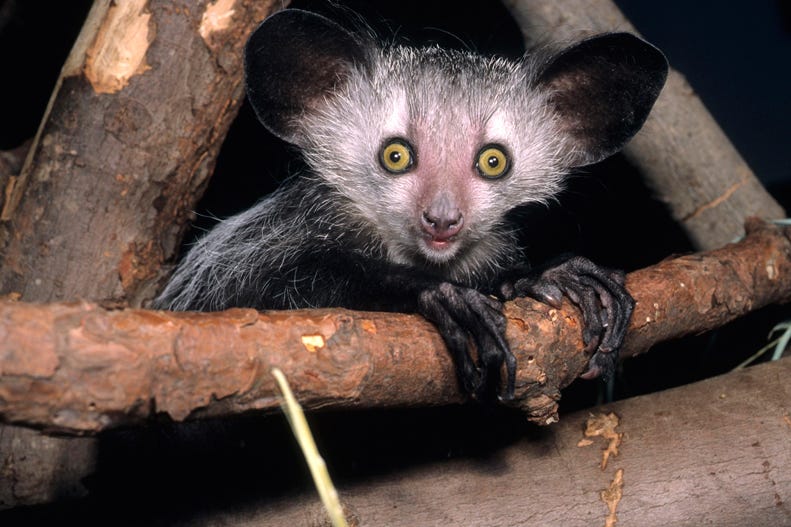The natural world is full of fascinating and rare creatures, but few are as bizarre and intriguing as the Aye-Aye (Daubentonia madagascariensis). Found only on the island of Madagascar, this unusual primate has long been shrouded in mystery and superstition. Despite its unique adaptations and important role in the ecosystem, the Aye-Aye is critically endangered due to habitat destruction and human misconceptions. This article delves into the life of this extraordinary animal, exploring its biology, behavior, and the conservation challenges it faces.
A Peculiar Primate
The Aye-Aye is a member of the lemur family, though its strange appearance often leads people to mistake it for a rodent or some other unrelated creature. With its large, glowing eyes, bat-like ears, and an elongated, skeletal middle finger, the Aye-Aye looks like something out of a fantasy tale. Adults typically measure about 14-17 inches (35-44 cm) in body length, with a long bushy tail that can add an additional 24 inches (60 cm) to its total size. Its dense, dark fur and eerie facial features only add to its otherworldly aura.
Unique Foraging Techniques
One of the most fascinating characteristics of the Aye-Aye is its highly specialized foraging method, which is known as percussive foraging. The Aye-Aye taps on tree trunks and branches with its elongated middle finger, using echolocation-like abilities to detect hollow cavities where insect larvae might be hiding. Once it locates its prey, it uses its sharp teeth to gnaw into the wood and then employs its long, flexible finger to extract the grubs from the hole. This behavior is strikingly similar to that of a woodpecker, making the Aye-Aye one of the only mammals known to use this technique.
In addition to insects, Aye-Ayes also consume fruit, nectar, seeds, and fungi, making them omnivorous. Their ability to exploit various food sources allows them to thrive in diverse forest environments, from rainforests to dry deciduous woodlands.
Nocturnal and Solitary Lifestyle
Aye-Ayes are strictly nocturnal, meaning they are active at night and spend their days sleeping in nests made from leaves and twigs. They are highly solitary animals, with individuals maintaining large home ranges and only coming together briefly for mating. Communication among Aye-Ayes is primarily done through scent marking and occasional vocalizations.
Due to their elusive nature and preference for high tree canopies, Aye-Ayes are rarely seen in the wild, contributing to their mystique. Their ability to move swiftly and stealthily among the treetops makes them difficult for researchers to observe and study.
Superstitions and Threats
Unfortunately, the Aye-Aye has long been associated with bad omens and superstitions in Malagasy folklore. Many local beliefs consider the Aye-Aye a harbinger of death, with some myths claiming that if an Aye-Aye points its long finger at someone, it will bring misfortune or even death to that person. As a result, these primates are often killed on sight by fearful villagers, exacerbating their population decline.
In addition to hunting due to superstition, Aye-Ayes face significant threats from deforestation and habitat destruction. Madagascar has one of the highest rates of deforestation in the world, with vast areas of its forests being cleared for agriculture, logging, and human settlement expansion. This loss of habitat puts immense pressure on Aye-Aye populations, reducing their available food sources and nesting sites.
Conservation Efforts
Despite these challenges, there are ongoing efforts to conserve Aye-Aye populations. Several organizations, including the Durrell Wildlife Conservation Trust and Madagascar National Parks, have been working to protect Aye-Ayes and their habitats. Conservation strategies include:
- Habitat Protection: Establishing and expanding protected areas where Aye-Ayes can live undisturbed.
- Community Education: Educating local communities about the ecological importance of Aye-Ayes and dispelling harmful myths about them.
- Captive Breeding Programs: Institutions like the Duke Lemur Center in the United States are involved in breeding programs to ensure the species’ survival in case wild populations continue to decline.
The Aye-Aye is one of nature’s most unique and misunderstood creatures. As a nocturnal primate with extraordinary adaptations, it plays a crucial role in Madagascar’s ecosystem. However, human superstitions and habitat destruction pose serious threats to its survival. Through education, conservation, and continued research, we can help ensure that future generations have the opportunity to marvel at this rare and fascinating animal. By raising awareness and protecting their environment, we can prevent the Aye-Aye from fading into extinction and allow it to continue thriving in the wild.

